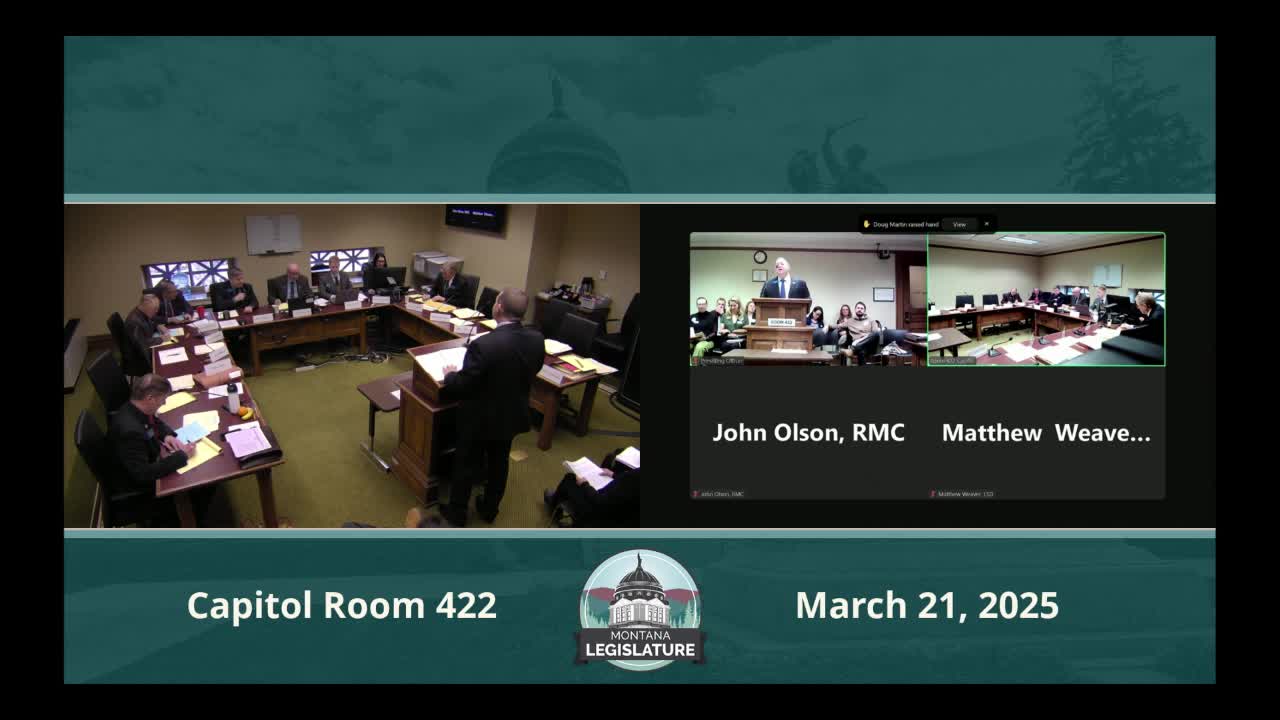Lawmakers hear bill to change Medicaid payments for physical, occupational and speech therapists
March 21, 2025 | 2025 Legislature MT, Montana
This article was created by AI summarizing key points discussed. AI makes mistakes, so for full details and context, please refer to the video of the full meeting. Please report any errors so we can fix them. Report an error »

Representative Ed Buttry introduced House Bill 585 to the Senate Business and Labor Committee, proposing a conversion-factor/relative-value-unit approach to set Medicaid reimbursement rates for physical therapists (PT), occupational therapists (OT) and speech-language pathologists (SLP).
Buttry told the committee that the professions were excluded from a 2022 state rate study and that current Medicaid payments do not cover labor and overhead. "When a physical therapist sees a patient, they lose about $44 an hour. When an SLP sees a patient, they lose about $68 an hour and an OT loses $51 an hour," Buttry said while explaining the financial unsustainability for many small providers.
Proponents from the professions said small, community-based clinics are struggling. Jennifer Hensley, who submitted statements from therapists across the state, asked the committee for a due pass and described providers going out of business. "These are medical professionals, masters trained, and they're also asking for a due pass," Hensley said.
Emily Herndon, a doctor of physical therapy and president of the American Physical Therapy Association chapter in Montana, told the committee nearly half of Montana PTs work in small businesses and said statewide research showed PTs losing an average of $44 per hour treating Medicaid patients. She also told the committee that when her group requested claim data from the Department of Administration it was billed $114.05 for that data.
Sponsor Buttry described the bill’s mechanics: reimbursement would be calculated by multiplying a conversion factor by the relative value unit (RVU) assigned to each service. The sponsor cited a proposed conversion factor of 39.56 for fiscal year 2026, and said the bill originally included an inflationary increase tied to the consumer price index; House Appropriations intended to remove that inflation adjustment but the committee transmittal timeline had not allowed that change before the House passed the bill.
Supporters said the proposed methodology mirrors an approach used previously for physician reimbursement and would be intended to set a sustainable baseline for small providers. Witnesses urged inclusion of a broader provider-rate increase; one witness noted section B of the bill had a 3% across-the-board increase they hoped would be retained.
The hearing record did not show a formal committee vote. Proponents made repeated requests for a "due pass" to move the bill forward for further consideration and for lawmakers to consider adjustments that reflect operating costs in small clinics.
Buttry told the committee that the professions were excluded from a 2022 state rate study and that current Medicaid payments do not cover labor and overhead. "When a physical therapist sees a patient, they lose about $44 an hour. When an SLP sees a patient, they lose about $68 an hour and an OT loses $51 an hour," Buttry said while explaining the financial unsustainability for many small providers.
Proponents from the professions said small, community-based clinics are struggling. Jennifer Hensley, who submitted statements from therapists across the state, asked the committee for a due pass and described providers going out of business. "These are medical professionals, masters trained, and they're also asking for a due pass," Hensley said.
Emily Herndon, a doctor of physical therapy and president of the American Physical Therapy Association chapter in Montana, told the committee nearly half of Montana PTs work in small businesses and said statewide research showed PTs losing an average of $44 per hour treating Medicaid patients. She also told the committee that when her group requested claim data from the Department of Administration it was billed $114.05 for that data.
Sponsor Buttry described the bill’s mechanics: reimbursement would be calculated by multiplying a conversion factor by the relative value unit (RVU) assigned to each service. The sponsor cited a proposed conversion factor of 39.56 for fiscal year 2026, and said the bill originally included an inflationary increase tied to the consumer price index; House Appropriations intended to remove that inflation adjustment but the committee transmittal timeline had not allowed that change before the House passed the bill.
Supporters said the proposed methodology mirrors an approach used previously for physician reimbursement and would be intended to set a sustainable baseline for small providers. Witnesses urged inclusion of a broader provider-rate increase; one witness noted section B of the bill had a 3% across-the-board increase they hoped would be retained.
The hearing record did not show a formal committee vote. Proponents made repeated requests for a "due pass" to move the bill forward for further consideration and for lawmakers to consider adjustments that reflect operating costs in small clinics.
View full meeting
This article is based on a recent meeting—watch the full video and explore the complete transcript for deeper insights into the discussion.
View full meeting
